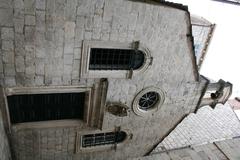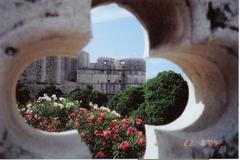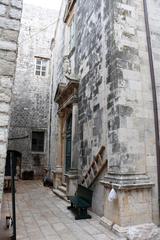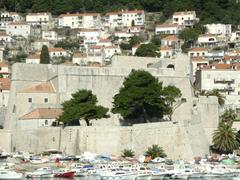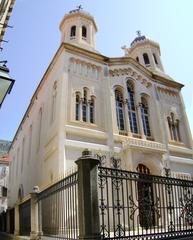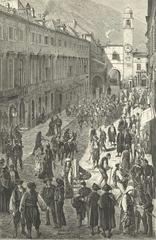Comprehensive Guide to Visiting the Walls of Dubrovnik, Dubrovnik, Croatia
Date: 01/08/2024
Introduction
The Walls of Dubrovnik, a paramount symbol of Croatia’s historical and architectural heritage, stand as a testament to the city’s resilience and strategic importance over centuries. These fortifications, which date back to the Early Middle Ages, offer a unique glimpse into the past, marking Dubrovnik as a significant maritime republic. Initially constructed around the 8th century, the walls have undergone numerous expansions and reinforcements, particularly from the 12th to the 17th centuries, to become one of Europe’s most formidable defensive structures (Wikipedia, Ancient Origins). Today, they not only serve as a historical monument but also attract over a million visitors annually, offering panoramic views of the Adriatic Sea and the Old Town’s iconic red-tiled roofs (Kompas). This comprehensive guide will delve into the rich history of the walls, provide essential visiting information, and offer tips to enhance your experience.
Table of Contents
- Introduction
- Historical Background of the Walls of Dubrovnik
- Key Features and Structures
- Visiting Information
- Preservation and Maintenance
- Visitor Experience
- Frequently Asked Questions
- Conclusion
Historical Background of the Walls of Dubrovnik
Early Beginnings and Initial Construction
The origins of the Walls of Dubrovnik can be traced back to the Early Middle Ages. The initial construction of the fortifications began towards the end of the 8th century, with the first limestone forts erected around the city (Wikipedia). These early defenses were relatively simple, consisting of stone ramparts and wooden palisades. However, they proved effective, as evidenced by their ability to withstand a 15-month siege by the Saracens in the 9th century (Ancient Origins).
Expansion and Reinforcement
As Dubrovnik grew in importance as a trading center and naval power, the need for more robust defenses became apparent. The 12th century marked the beginning of significant expansions and reinforcements of the city walls. The wooden palisades were replaced with stone battlements, and the walls were made thicker to better withstand attacks (Ancient Origins).
During the 13th century, the city walls began to take on their current form. The construction was systematic and continued up to the 17th century. By the 14th century, the walls had been expanded to encircle the entire city, and various towers and forts were added along its length (Kompas). This period also saw the inclusion of the Dominican Monastery into the defensive structure, further strengthening the city’s fortifications (History Hit).
The Golden Age and Final Form
The definitive shape of the Dubrovnik city walls was established around the fall of Constantinople in 1453, a period often referred to as the ‘Golden Age’ of Dubrovnik (History Hit). By this time, the walls measured approximately 1,940 meters (6,360 feet) in length and reached a maximum height of about 25 meters (82 feet) (Wikipedia). The walls were further reinforced with 16 towers, three fortresses, and six bastions, making them one of the most formidable defensive structures in Europe (Kompas).
Resilience Through the Ages
The Walls of Dubrovnik have stood the test of time, not only due to the skilled construction workers and the constant care provided by city dwellers but also because of the city’s diplomatic prowess. The Republic of Ragusa, as Dubrovnik was known, managed to avoid many conflicts through shrewd diplomacy, ensuring the preservation of its fortifications (Wikipedia).
In 1667, a massive earthquake struck the region, causing significant damage to Dubrovnik. However, the city walls largely survived, a testament to their robust construction (The Happy Jetlagger). Later, during the Yugoslav War in 1991, the walls once again proved their worth. The medieval fortress system played a crucial role in protecting the Croatian population during the siege by the Yugoslav People’s Army (The Happy Jetlagger).
UNESCO World Heritage Site
In recognition of their historical and cultural significance, the old city of Dubrovnik, including its walls, was inscribed as a UNESCO World Heritage Site in 1979 (Wikipedia). This designation has helped ensure the continued preservation and maintenance of the walls, allowing them to remain one of the most iconic and well-preserved medieval fortifications in the world.
Modern-Day Significance
Today, the Walls of Dubrovnik are one of the most popular tourist attractions in Croatia, drawing over 1.2 million visitors in 2019 (Wikipedia). The walls offer breathtaking views of the Adriatic Sea, the red-tiled roofs of the Old Town, and the lush green hills surrounding the city. Walking the walls is a unique experience that allows visitors to step back in time and appreciate the city’s rich history and architectural beauty (Kompas).
Key Features and Structures
The walls are dotted with several key features and structures that highlight their historical significance. One of the most impressive is the Pile Gate, a robust Gothic construction dating back to 1537, which serves as the usual starting point for a walk around the walls (History Hit). Another notable structure is the Lovrijenac Fortress, a detached fortress rising 37 meters above sea level, named after St. Lawrence (Kompas).
Visiting Information
- Ticket Prices: Tickets for the Walls of Dubrovnik are priced at approximately 200 HRK for adults and 50 HRK for children. Discounts are available for group bookings and Dubrovnik cardholders.
- Opening Hours: The walls are open daily from 8:00 AM to 7:30 PM during the summer months (April to October) and from 9:00 AM to 3:00 PM in the winter months (November to March).
- Special Events: Guided tours and special events are often held, providing deeper insights into the walls’ history and architecture. Check the official Dubrovnik tourism website for the latest information.
- Travel Tips: To avoid the intense midday sun and large crowds, the best times to visit are early in the morning or late in the afternoon. Wear comfortable shoes, bring a hat, sunscreen, and water.
- Nearby Attractions: Other nearby attractions include the Rector’s Palace, the Dubrovnik Cathedral, and the Franciscan Monastery, all within walking distance of the city walls.
Preservation and Maintenance
The preservation and maintenance of the Walls of Dubrovnik are overseen by the Society of Friends of Dubrovnik Antiquities. The funds generated from the sale of entrance tickets are used to maintain these historic structures, ensuring their continued survival for future generations (Chasing the Donkey).
Visitor Experience
Walking the Walls of Dubrovnik is a must-do activity for anyone visiting the city. The walk takes approximately 1.5 to 2 hours, depending on the pace and the number of stops for photos. Visitors are advised to wear comfortable shoes, bring a hat, sunscreen, and water to ensure a pleasant experience (Chasing the Donkey).
Frequently Asked Questions
- What are the visiting hours for the Walls of Dubrovnik? The walls are open daily from 8:00 AM to 7:30 PM during the summer months and from 9:00 AM to 3:00 PM in the winter months.
- How much are tickets to the Walls of Dubrovnik? Tickets are priced at approximately 200 HRK for adults and 50 HRK for children, with discounts for group bookings and Dubrovnik cardholders.
- What should I wear when visiting the Walls of Dubrovnik? Visitors are advised to wear comfortable shoes, bring a hat, sunscreen, and water.
Conclusion
In conclusion, the Walls of Dubrovnik encapsulate the city’s rich history, architectural brilliance, and resilient spirit. As one of the most well-preserved medieval fortifications in the world, they offer an unparalleled experience to visitors, blending historical insights with breathtaking views. Whether you’re exploring the Gothic Pile Gate, the towering Fort Minceta, or taking in the views from Lovrijenac Fortress, each step along the walls connects you to Dubrovnik’s storied past. With detailed ticketing information, optimal visiting times, and practical travel tips, this guide aims to ensure that your visit to the Walls of Dubrovnik is both enriching and memorable. Don’t forget to explore nearby attractions like the Rector’s Palace and the Dubrovnik Cathedral to complete your historical journey through this remarkable city (Wikipedia, Kompas, Chasing the Donkey). For more travel tips and updates, download our mobile app Audiala and follow us on social media.
References
- Wikipedia, 2024, Various Authors source
- Ancient Origins, 2024, Various Authors source
- Kompas, 2024, Various Authors source
- History Hit, 2024, Various Authors source
- The Happy Jetlagger, 2024, Various Authors source
- Chasing the Donkey, 2024, Various Authors source
- Culture Trekking, 2024, Various Authors source
- We Are Craving Adventure, 2024, Various Authors source
- Restless Adventurer, 2024, Various Authors source
- Walkabout Croatia, 2024, Various Authors source
- Sand in My Suitcase, 2024, Various Authors source
